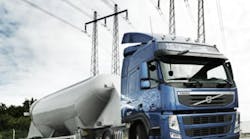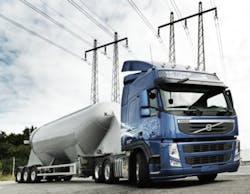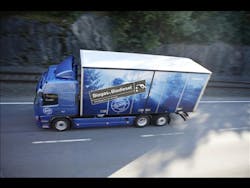Sweden’s Volvo Trucks is in the midst of testing a new technological package that aims to squeeze more fuel economy out of modern-day big rigs – using an “autopilot” style system in an attempt to control and capture the “kinetic energy” created when using a truck’s brakes, helping boost fuel economy by 5%.
This new system – dubbed “I-See” – aims to harness such “kinetic energy” to aid in truck propulsion. Volvo’s Anders Eriksson explained that kinetic energy is the mechanical work needed to reduce an object’s speed to zero. When an object in motion is slowed down, its kinetic energy has to be transformed into some other form of energy – thus, when a truck hits the brakes, its kinetic energy is converted into heat, he said.
What Volvo’s I-See system aims to do is harness the kinetic energy produced by a truck’s brakes to help “push” the vehicle up hills, then use that same energy on downhill gradients for acceleration – all without tapping the engine. Again, Ericksson said Volvo’s tests so far show that using kinetic energy in this manner can reduce fuel consumption by 5%.
“If kinetic energy can be exploited to a greater extent, it may help cut fuel consumption,” he pointed out. “This will benefit both the environment and the industry’s economy, something that is very important today as fuel costs are becoming an increasingly heavy burden on many haulage firms.”
[Why Europeans call trucking companies “haulage firms,” though, is beyond me.]
The way it works, Ericksson said, is that “I-See” controller gets linked to the transmission’s tilt sensor, obtaining information about the road topography digitally and then making gear changes accordingly.“I-See is an ‘autopilot’ linked to the truck’s cruise control, taking over and handling gear changes, throttle and brakes on gradients, ensuring they all operate in the most fuel-efficient way possible,” explained Hayder Wokil, product manager at Volvo Trucks – the parent company (as if you didn’t know) of Volvo Trucks North America on this side of the pond.
“I-See ‘freewheels’ as much as possible so on certain stretches of road no fuel is used at all,” he added. “In this way fuel consumption can be cut by up to 5%; a figure based on the results of simulations and tests on public roads.”
Basically, I-See carries out six different operations to tap into a truck’s kinetic energy. For instance, I-See accelerates up hills, remains in a high gear for as long as possible and then “freewheels” on descents to exploit the truck’s weight as a propulsion motor.
“I-See works best in undulating terrain,” said Eriksson. “With moderately long and steep slopes, I-See ensures that you can freewheel for long distances without using the engine – and it is this freewheeling capability that makes the system special, for when the truck rolls freely, virtually no fuel is used.”
But in order to successfully “freewheel,” a whole lot of data is required, he stressed. “It imposes high demands on precision,” Ericksson said. “For instance, you have to know whether your speed will drop or increase over the next stretch of road. A gradient of just a few percent can be the decisive factor.”Other factors that make a difference are air resistance and the truck’s weight. All told the system has to keep track of and process a lot of information, he noted.
I-See also requires use of the cruise control, and Volvo’s data indicates that on average European truck drivers use cruise control about half the time.
Thus, for a truck in normal operation, covering 140,000 kilometers a year (about 86,992 miles annually) fuel savings should total some 1,000 liters or a little over 264 gallons per year.
“This makes a big difference to a haulage firm’s profitability,” Wokil noted. “But unlike a driver, I-See never gets tired – it’s like an autopilot. This also allows the driver to focus more on the surrounding traffic and other aspects of the journey. And an alert driver is a better driver. That’s something we know for sure.”





